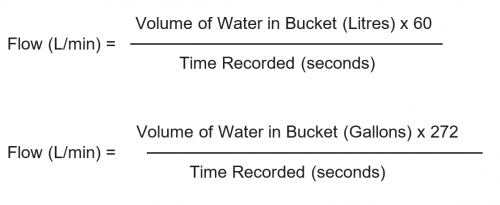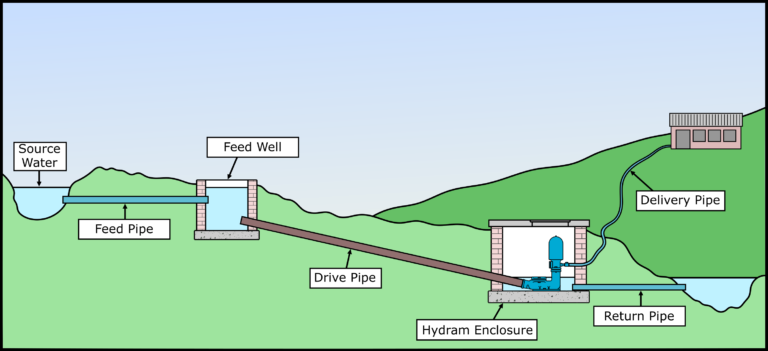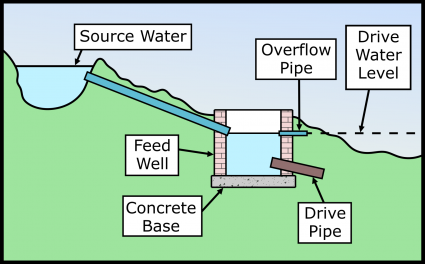How to install a manufactured hydraulic ram pump, including sizing etc.
Source: Blake’s Hydram
Basic Installation
At its most basic, installing a Blake’s Hydram requires the following steps.
- First create a feed well to collect the source water.
- Second lay a concrete slab on which to bolt the Hydram.
- Third fix a drive pipe between the two.
- Then install a delivery pipe from the Hydram to where the water needs to go.
Measuring Drive Water
Small Streams
The easiest method to measure the flow of small streams and springs is to dam up the stream. Then insert a short piece of pipe to form a spout.
One person should then use a bucket to collect the water from the spout. A second person times a 15, 30 or 60 second interval. By measuring the amount of water in the bucket in Litres over this time period, the flow of water in Litres per minute can be easily calculated.

Working Fall
The working fall is an important predetermined vertical distance from the surface of the water in the feed well, down to the level of the top of the Hydram waste valve. In general, the greater the working fall, the more water a Hydram will pump.
The minimum recommended working fall is 1.1m. Please contact Allspeeds for falls greater than 12m.
Feed Well
This serves as a collection tank for the source water and is built on the mouth of the drive pipe. It is usual to lay a concrete base and form the tank is brick or concrete. The top should be covered over to prevent pollution, but not made airtight.
If the surface of the water in the feed well is lower than the level of the source water, then an overflow pipe should be incorporated in the feed well. This will ensure that a constant level of water is maintained.
Feed Well Size
Recommended sizes of feed well are listed below. It is better to make the tank larger rather than smaller.
| Hydram Size | Feed Well Size (Internal Dimensions) |
Depth (Below Water Level) |
|---|---|---|
| 1, 2 & 3 | 0.7m² | 0.6m |
| 3.5 & 4 | 0.75m² | 0.75m |
| 5, 6 & 7 | 1.1m² | 1.1m |
| 8 | 1.2m² | 1.2m |
| 10 | 1.5m² | 1.5m |
Feed Pipe
Usually water must be conveyed from the source to the feed well. This can be done by laying the feed pipe from the source to the feed well. This pipe may be of plastic or any other suitable material. For lengths up to 150 metres, the following pipe sizes may be used as a guide and these will not cause a head loss of more than 150mm. (For Hydrams working on falls of 2m or less, or for longer distances, allowances will have to be made for head loss from the source to the feed well – please refer to us.)
| Flow (Litres per Minute) |
Feed Pipe Bore (mm) |
|---|---|
| Up to 30 | 75 |
| 30 – 90 | 100 |
| 90 – 180 | 125 |
| 180 – 360 | 150 |
| 360 – 900 | 225 |
Hydram Base
This provides a surface on which the Hydram may be bolted and which absorbs the pulsations when the Hydram is working. At the minimum it can be a simple concrete slab not less than 150mm thick for the Hydram sizes 1 & 2 and 225mm thick for sizes 3, 3.5, 4 & 5.
The Surface of this base must be a distance below the surface of the water in the feed well equal to the working fall plus the depth of the waste valve. This depth is shown in the table below.
| Hydram Size | Waste Valve Depth (mm) |
|---|---|
| 1 | 125 |
| 2 | 150 |
| 3 | 175 |
| 3.5 | 200 |
| 4 | 225 |
| 5 | 250 |
It is usual to construct a cover around and over the Hydram to protect it and prevent pollution. This is essential where the Hydram is sunk in to a pit to gain the necessary fall. Arrangements must be made for access and servicing and also for the excess water to drain back in to the source at some lower point. Drawings showing the foundations and housings up to size 5 Hydrams are available here and for size 6 and larger contact Allspeeds.
We recommend that the enclosure is constructed of brick or concrete for durability.
Drive Pipe
The drive pipe is a very important part of the Hydram and it should be laid straight with an even fall from the feed well to the Hydram. Please see here for more information on drive pipe layouts.
We strongly recommend the use of heavy wall steel tube for the drive pipe. Up to 150mm bore is available in 7 metre lengths of galvanised steel tube, screw and socketed, to BS 1387. Hydrams up to size 3 have a threaded body to take his pipe directly. For larger Hydrams, please contact Allspeeds.
Plastic drive pipes may be used in certain limited circumstances e.g. for small Hydrams where the fall and lift are low but please consult us first as a plastic drive pipe is likely to cause the Hydram to not work.
The length of the drive pipe is also important and as a general rule for falls greater than 2 metres, it should be between 3.5x and 5x the fall. For a fall of 10m, the length should be between 35m minimum and 50m maximum. For falls of 2m or less, the drive pipe should be made less than 7m long (i.e. one length of pipe).
The following are the standard sizes of drive pipe for each Hydram. Do not deviate from these sizes without first contacting Allspeeds.
| Hydram Size | Drive Pipe Bore (mm) |
Drive Pipe Bore (inches) |
|---|---|---|
| 1 | 32 | 1¼ |
| 2 | 38 | 1½ |
| 3 | 50 | 2 |
| 3.5 | 65 | 2½ |
| 4 | 75 | 3 |
| 5 | 100 | 4 |
| 6 | 125 | 5 |
| 7 | 150 | 6 |
| 8 | 175 | 7 |
| 10 | 200 | 8 |
Delivery Pipe
Plastic pipe may be used for the delivery pipe, assuming the pressure rating is suitable. The Hydram delivery outlet is fitted with a non-return valve to which the delivery pipe can be fixed. This valve prevents the delivery pipe emptying if disconnected from the Hydram for any reason e.g. servicing.
The diameter of the delivery pipe depends on the length being used and the height and volumes of water being pumped. We will gladly advise on this.
It is usual to deliver the water into a holding tank at the highest point, from where it can be distributed by gravity to the points of use. This holding tank should have an overflow so that any excess water can drain away. The delivery pipe outlet should not be fitted with a ball float shut-off valve, since this would stop the Hydram. In contrast any branches taken off the delivery pipe lower down should be fitted with float valves. This is so that when their demand is satisfied, water continues to the highest levels. Delivery branches must not be taken off the main delivery pipe until a vertical height equal to three times the fall has been reached, otherwise the Hydram will not run reliably.
Source: Blake’s Hydram



